Attention real-estate nerds: Come see the Williamsburgh Savings Bank’s landmarked interior during Smorgasburg and Brooklyn Flea
Eye On Real Estate

In cold-weather months,Smorgasburg moves indoors to the Williamsburgh Savings Bank. Eagle photos by Lore Croghan
You know you’re a real-estate nerd when you go to the fall-and-winter Smorgasburg and Brooklyn Flea because you want to look at the landmarked interior of the Williamsburgh Savings Bank.
It’s great fun to sample the fabulous fare at the weekend foodie fest inside the Brooklyn Cultural District’s famous clock-topped 1920s-vintage skyscraper — and buy vintage clothing, antique knickknacks and midcentury furniture at sister market Brooklyn Flea.
But.
